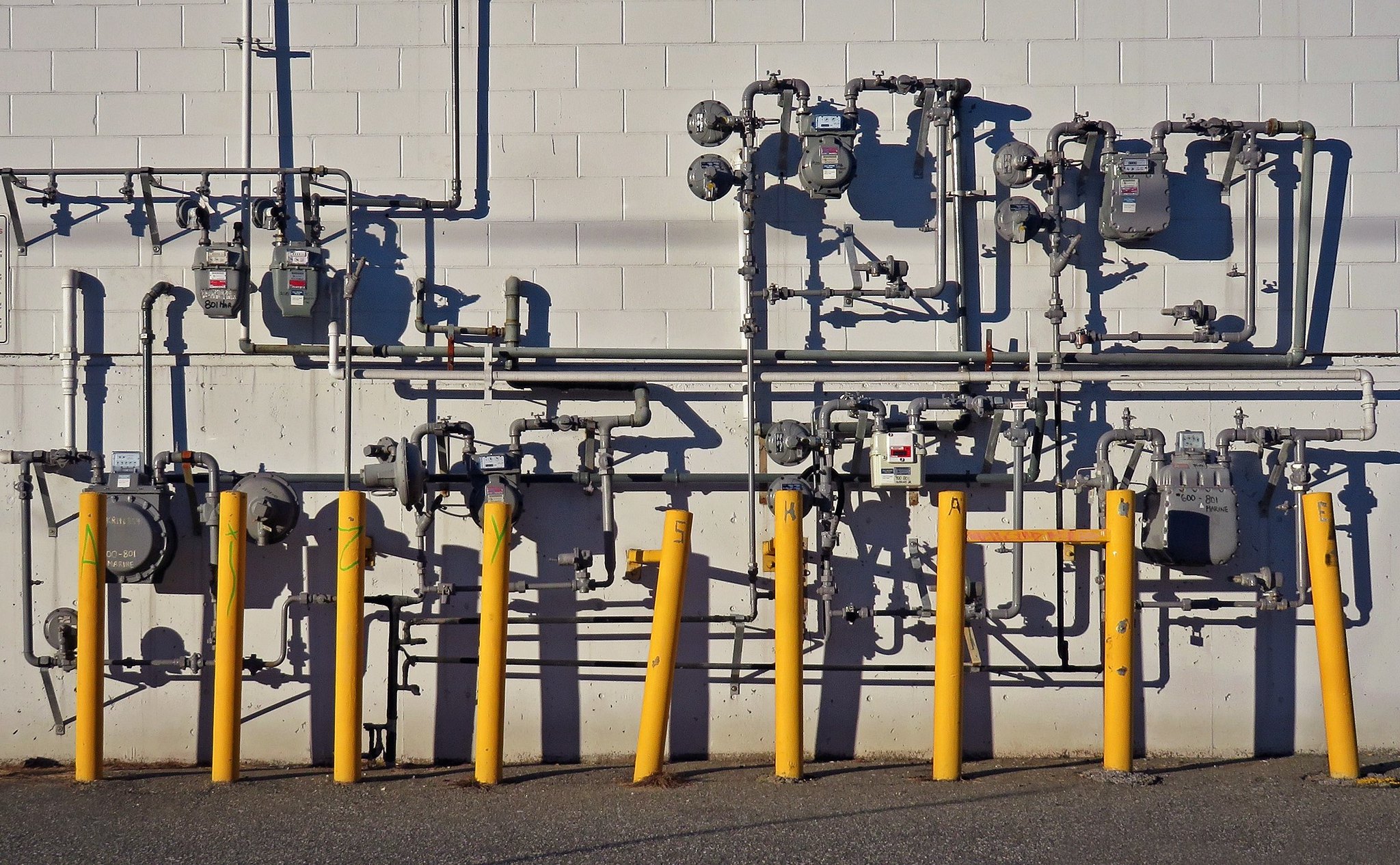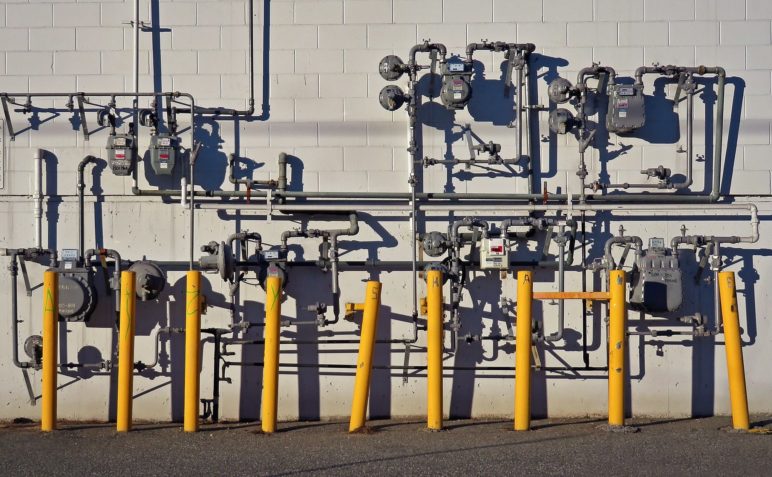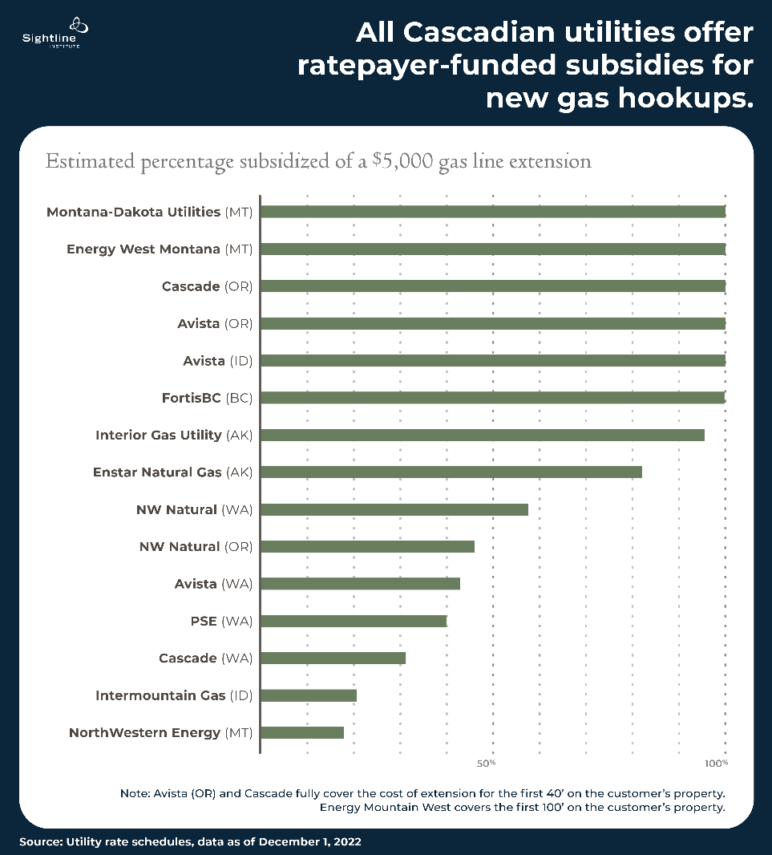To meet climate commitments, the natural gas system across Cascadia must begin to shrink. Even sooner, it must plateau. But a widely used regulatory policy called “line extension allowances” (or “line extension subsidies”) authorizes gas utilities to promote just the opposite. These allowances, offered by gas utilities and paid for by current gas customers, encourage steady growth of the polluting system by subsidizing the cost of fossil fuel infrastructure build-out.
In 2023, California will become the first state in the United States to eliminate line extension allowances because of their harmful climate, economic, and health impacts. Some regulators in Cascadia have taken steps to reduce the subsidies, but they remain on the books throughout most of the region. Regulators in the Northwest would be smart to follow their California counterparts’ lead and eliminate these counterproductive subsidies entirely.
Line extension allowances perversely incentivize gas system growth
Without any subsidies, a developer or homeowner could expect to pay thousands of dollars to hook up a building to a gas distribution pipeline. This hefty price could encourage homeowners or developers to forgo polluting gas appliances (like gas furnaces) and instead opt for cleaner electric alternatives (like heat pumps).
But in a perverse incentive for the climate, regulators allow gas utilities to eliminate some or all of the cost of new gas connections through line extension subsidies. Even worse, existing gas customers (ratepayers) foot the bill for the subsidies, most likely without knowing it.
All gas utilities in Cascadia offer line extension allowances of varying amounts and with different structures. Say a developer needs to hook up a new home or business to gas service, and it’s going to cost $5,000. The chart below shows the estimated percentage of this cost that each gas utility in the region would subsidize under its current policies. The percentage subsidized is in blue, and the percentage the new gas customer or developer would pay out of pocket is in orange. Most Cascadian utilities would subsidize at least half of a $5,000 hook-up. Five, including Avista and Cascade in Oregon, would fully cover it through ratepayer dollars. (See appendix for details on each utility’s line extension allowance as of December 2022.)
Due to line extension subsidies, Cascadian gas pipes continue to proliferate, adding thousands of new customers every year. Utilities in Oregon and Washington alone connected 61,000 residential customers to the gas system in 2020 and 2021, a roughly 3 percent increase from 2019 customer counts.1 Ratepayers in these states likely paid more than $100 million a year to cover the cost of the subsidies that made those new connections possible—and further entrenched the gas industry in our energy future.2
The arguments for line extension allowances are stale
While justifications for the subsidies vary by region and utility, the typical economic rationale is that connecting more customers to the gas network is better and cheaper for everyone. That’s because utilities can spread fixed costs for the entire system over more households, thereby lowering rates for all and more than offsetting the price existing customers pay to subsidize new ones. State utility commissions have also touted the subsidies as necessary to boost “economic development” and “promote equitable access among residential ratepayers” to the gas system.
But the arguments supporting line extension allowances crumble in light of growing knowledge about the health and climate hazards of gas and corresponding anticipated declines in its use. As gas utilities’ customer base shrinks, which it will with widespread electrification, the costs of maintaining and operating a larger gas footprint will drive rates higher for those still connected to the system. That means line extension allowances incentivize customers to connect to a system that will soon become much costlier to them.
Plus, homeowners now enjoy a cost-competitive and cleaner alternative to gas: all-electric homes. Incentives for high-efficiency electrification, coupled with avoiding spiking natural gas prices and harnessing the energy efficiency benefits of electric heat pumps, easily save consumers money compared with installing gas appliances. With the new economics of electric homes, it makes even less sense to incentivize gas use and gas pipe expansion through line extension allowances.
Regulators are starting to reconsider line extension allowances but have not yet rooted them out
Some regulators are starting to reconsider and do away with line extension allowances. In September 2022, California utility regulators eliminated the subsidies, citing the state’s emissions reduction target. The regulatory change, which goes into effect in July 2023, aims to reduce the number of stranded assets (new pipelines built that utilities decommission before they are fully depreciated) and to accelerate electrification. The state expects to save ratepayers approximately $164 million annually by eliminating line extension allowances.
In 2021 the Washington Utilities and Transportation Commission (WUTC) cut line extension allowances roughly in half. A year later, the WUTC required Avista and Puget Sound Energy (PSE) to eliminate gas line extension allowances by January 1, 2025, following negotiations with several rate case interveners, including Sierra Club and NW Energy Coalition. Once Avista and PSE weed out the subsidies, they will still be able to connect new customers to gas, but homeowners and developers will have to pay full freight—a major disincentive. In Oregon, the Public Utilities Commission (PUC) recently issued its final orders in the NW Natural rate case, which will reduce the utility’s line extension allowance to $1,380 per connection, a 40 percent drop from its current level.
But Cascadian regulators and policymakers have more to do to weed out these harmful subsidies. In Washington, regulators continue to permit the two other gas utilities, Cascade and NW Natural to offer line extension allowances. Likewise, in Oregon, the PUC order falls short of eliminating the NW Natural subsidies altogether. And the PUC has not touched the line extension allowances that the two other gas utilities in Oregon, Avista and Cascade, provide. In an investigation examining the effect of greenhouse gas emissions regulation on gas ratepayers in the state, the PUC signed itself up to create an approach to line extension subsidies in future rate cases that better accounts for the state’s climate policies. Regulators in Oregon and Washington should take proactive steps to universally eliminate line extension allowances across the states’ gas utilities.
Elsewhere in Cascadia, regulators are further behind. Utility commissions in Idaho, Montana, Alaska, and British Columbia have not proposed reducing or eliminating the subsidies. In fact, both FortisBC in British Columbia and Enstar Natural Gas in Alaska petitioned regulators to increase their line extension allowances in recent years. FortisBC succeeded in gaining regulatory approval to shrink customers’ out-of-pocket expenses for a line extension to a flat rate of C$15 after arguing that customers in rural communities faced unequitable costs to connect to the pipeline compared to Vancouverites. Alaska regulators denied the request by Enstar Natural Gas to lower customer contributions to $500 from $688 (2020) because the utility failed to provide any cost justification for the reduction or objective criteria for changing the fee. Neither regulatory body examined the impacts of the subsidies on human health or climate pollution.
As Cascadians tackle climate change and strive to lower emissions, line extension allowances are snarling progress. Regulators across the region would be smart to follow California’s lead and weed out these subsidies that perversely encourage creep of the gas system and household use of polluting, unhealthy gas. Two large gas utilities in Washington, PSE and Avista, are likely to be the first gas utilities in Cascadia to end these allowances. Regulators across Cascadia should waste no time making a formal, universal policy that eliminates these subsidies entirely.
Appendix
Table 1. All gas utilities in Cascadia currently offer line extension allowances, subsidies that existing gas customers pay for that reduce the cost of gas connections for new customers |
| Utility | Subsidized amount of new gas connection as of 2022
Line extension allowance |
| Washington | |
| PSE | $1,997 (will be eliminated in 2025) |
| Avista | $2,143 (will be eliminated in 2025) |
| Cascade Natural Gas | $1,560 |
| NW Natural | $2,875 |
| Oregon | |
| NW Natural | $2,300 (will be reduced by 40 percent by 2024) |
| Avista | Full cost of first 40 feet onto property |
| Cascade Natural Gas | Full cost of first 40 feet onto property |
| Alaska | |
| Enstar Natural Gas | Full cost less $895 contribution from customer |
| Interior Gas Utility | Full cost of gas line extension less $225 deposit from customer |
| Idaho | |
| Avista | Full cost of gas line extension |
| Intermountain Gas | $1,032 |
| Montana | |
| NorthWestern Energy | $890 |
| Montana-Dakota Utilities | Full cost of gas line extension |
| Energy West Montana | Full cost of first 100 feet onto property |
| British Columbia | |
| FortisBC | Full cost of gas line extension less C$15 deposit from customer |
Source: Utility rate schedules, data as of 12/1/2022
Note: Actual costs of a line extension differ depending on variables like length of line extension, size of service, and prevailing construction costs in an area. Sightline estimated the line extension allowances above based on average household gas usage.











